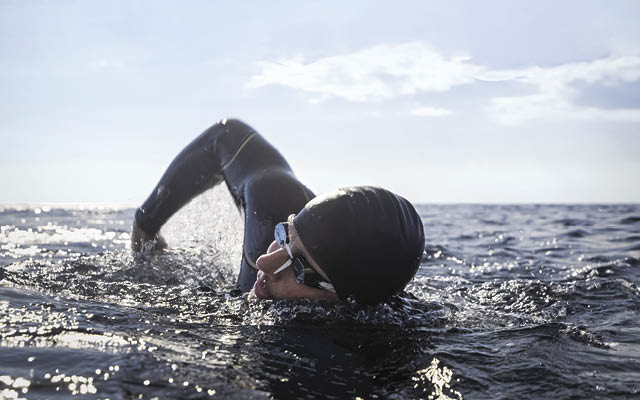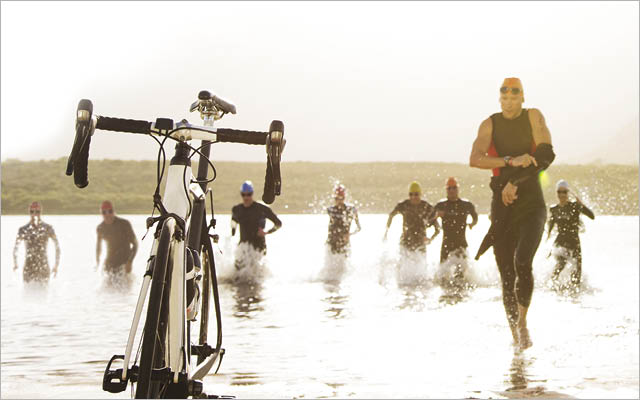Newcomers to triathlons may think they have enough to worry about just getting through the swim, bike and run. Dealing with the transitions, they reason, is something they’ll worry about later. “Take them seriously,” advises Dave Scott, triathlon coach and six-time Hawaii Ironman world champion. “It doesn’t make sense to put in serious training time, then dawdle during the transitions. You could easily eat up 30 seconds. Two transitions like that equal a full minute, which can mean 300 yards lost to a competitor.”
Sweat the Small Stuff
A bad transition can jinx your whole race. Getting lost in the transition area or scrambling to fix equipment, for example, will gobble up valuable time and throw you off your mental game. If you break a rule, even unwittingly, officials may tack a penalty onto your finish time, so thinking through your transitions ahead of time — and committing them to memory — can prevent costly mishaps.
The first transition, or T1, from swim to bike, can be the most precarious. You start the transition soaking wet and sometimes sealed in a difficult-to-remove wetsuit. Then you switch to biking, a sport that requires a significant amount of equipment that can cause a number of problems. Freshly pumped tires fizzle, chains fall off and seat posts loosen. You can change a flat and fix other mechanical problems in the transition area … but only if you remember to bring appropriate tools. Best-case scenario, you lose time. Worst case? You kiss your entry fee goodbye.
The second transition, or T2, from bike to run, is usually faster. Stow your cycle, change your shoes and you’re on your way. But it’s not always easy. Once, attempting to jettison his bike, Scott managed to knock down an entire rack of bikes, like toppling a line of dominoes. Countless athletes — pros and age-groupers alike — have started the run still wearing their helmets or left the transition area without their race numbers.
Jack Weiss, a USA Triathlon board member and owner of Texas- based Ironhead Race Productions, says one problem is that athletes don’t familiarize themselves with the transition area. “Even though we have arrows on the ground that say ‘run out’ or ‘bike out,’ I can’t tell you how many athletes stand there and ask, ‘Which way do I go?’”
One common mistake: not placing your bike in its designated spot. “It’s a chain reaction,” Weiss says. “If you rack yours in the wrong spot, then another person comes in and puts his in the wrong place, and on and on. All of a sudden you have total displacement and a lot of irate athletes.”
And unless race officials approve, don’t even think about riding your bike out of the transition area for a faster getaway. “It’s a competitive misdemeanor,” Weiss says. “It’s the same as blocking or drafting, depending on the length of the race.” It takes only three penalties to get disqualified.
Seconds to Shave
While there are certainly errors to avoid, there are also moves that you can learn to save time. Days, weeks or months before the triathlon, practice your transitions. “At the top level, you have to be fluid,” Scott says.
Practice “brick” workouts that combine two or more sports: swim to bike, or bike to run. Not only will this give your body a feel for the physical changes your muscles endure when switching sports, but it will also help you understand what clothing, equipment and food you’ll need.
Setting up a mock transition area will allow you to concentrate on improving your speed there. Certain maneuvers, such as clipping in and out of bike shoes, take practice. So, too, does getting out of a wetsuit. Time yourself and make any necessary adjustments.
Three for the Road
Even changes that save mere seconds can make a difference. Scott recommends the following:
- Under your wetsuit, put on what you plan to wear on the bike — with your race number attached. Once you’re soaked, it’s difficult to put on clothing.
- Smear a little Vaseline on the inside heels of your biking and running shoes. Add a dab to the footbed of each shoe, too, where the ball of your foot hits bottom when you initially slide in. Your feet will slip in easier.
- After biking, your legs and lower back can be stiff. In the last eighth-mile, stretch the muscles you’ll use for the run. Slow down and stand up on your pedals. Push your hips toward the bike stem with your hands on the brake hoods. Then drop each heel to stretch the calf muscles. You’ll encourage better blood flow to your extremities, which can help lengthen your stride and prevent cramping.
Transitions are as integral to triathlon as swimming, biking and running. Whether you adopt tips from veteran triathletes or create seconds-savers of your own, a few hours spent learning time-trimming transition techniques will almost always deliver enhanced race times.
Step-By-Step Setup
A good transition is all about planning. Here’s what you need to know about shaving seconds off your shifting times.
1. Make a checklist. Jot down everything you’ll need during each transition and stage of the race (see the checklist below for suggestions). Then pack your bag by imagining each event and picturing what gear you’ll use and the order in which you’ll need the items. Attach your race number to your tri-belt (a stretchy band with prongs designed to hold a race number, found at most running stores). Tag your bike or helmet with any additional numbers provided.
2. Arrive early. Get to the race site at least an hour before the gun goes off. Typically, the first order of business is body marking. A race volunteer will take a black permanent marker to your skin and, for the day, tattoo you with your race number and age. It’s best to delay applying sunscreen until after you’ve been marked so your numbers stay on. After a bike and helmet inspection, proceed to the transition area.
3. Note entries and exits. Where do you come in from the swim? Where do you go out on the bike? The transition area will look a lot different once it’s crowded with people, so orienting yourself now will give you a leg up later.
4. Tag your bike. Whether you have a designated space on a bike rack or you have to fend for yourself, the important thing is to remember exactly where you leave your bike. If you need to, attach a helium balloon, brightly colored hanky or other personal item to your spot on the rack, so you know where to go when the frenzy begins.
5. Avoid fancy footwork. Some triathletes clip their bike shoes into their pedals beforehand and put them on as they ride. This is a great way to save time, but it takes practice. If you don’t want to go that route, put your bike shoes toward the front of the towel for easy access. Keep your shoes unbuckled or un-Velcro-ed so you can easily get into them. If you don’t plan to wear socks, make sure to test your bare feet in your bike and running shoes before the race. Those few seconds for socks may save you from blisters.
6. Organize your space. Place running shoes toward the back of the towel with any other gear you plan to wear: singlet, cap, shorts, etc. Make sure your race number is visible but secured under a shoe so it doesn’t blow away. Once your shoes are on, you can take off with whatever is left and put it on as you run; whatever you do, make sure you have your race number.
7. Do a test drive. Take your bike for a quick spin before the event begins. Make sure everything is in working order and your tires are optimally inflated. (Remember, a hot day will make them expand.) Put your bike in the correct gear for starting, and make sure the handlebars won’t catch another competitor’s bike as you pull it from the rack.
8. Ward off sunburns. If your race lasts longer than two hours, the second transition is a good time to reapply sunscreen. You may also want to put on a cap to protect your face, screen your eyes from the sun and keep your wet hair out of the way.
9. Prime the fuel pump. If the race will take you less than an hour to complete, don’t worry about replacing lost carbs. But do be sure to have full water bottles secured to your bike. If you think the race will take an hour or more, stock enough fuel, such as carbohydrate drinks, gels and energy bars, to get you across the finish line. You can stash whatever you need in your singlet, waist pack or bike bag. (Don’t forget to also pack extra bike tubes, tools and other repair necessities.)
10. Consider comfort. You may want to keep a lubricant like Vaseline or Bodyglide handy to apply anywhere you experience chafing. Also, it’s worth shelling out a few bucks for lace locks or elastic laces — tying your shoes wastes precious seconds and getting them too loose or too tight can make for a less-than-stellar run.
Triathlon Transition List
The following are essentials for any triathlon setup.
- Race number
- Tri-belt
- Safety pins
- Sunscreen
- Swimsuit/wetsuit
- Two towels
- Two pairs of goggles
- Extra swim cap
- Bike
- Racing wheels
- Bike helmet
- Sunglasses
- Bike shoes
- Extra tubes
- Bike pump
- CO2 cartridges
- Water bottles
- Energy bars and gels
- Lubricant
- Running shoes
- Cap
- Singlet
- Socks
- Postrace clothes
This article originally appeared as “Smooth Transitions” in the June 2005 issue of Experience Life.


This Post Has 0 Comments